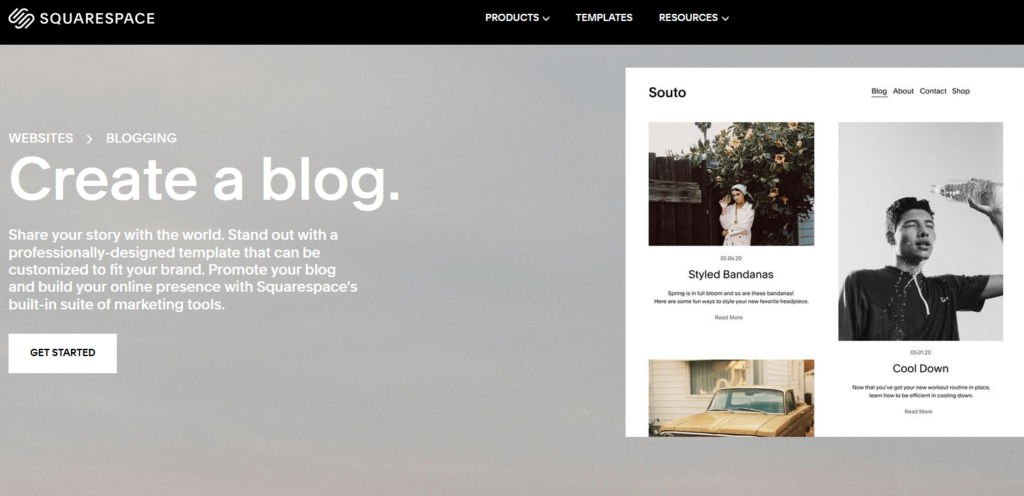Want to jump straight to the answer? The best blogging platform for most people is definitely Wix or WordPress with Bluehost Hosting.
When it comes to creating your own blog, you have two options:
The first is to build a website and host your blog there. Building your own website and blogging on it is the old-school way to build a blog. You have two ways to do this:
- Use an easy website builder like Wix.
- Use WordPress with Bluehost as your web host.
You can also use Squarespace to build your own blog site. That may be the preferable option, if you already have a web store on Squarespace.
Using one of these options requires more work up front, but you’ll own and control your site completely.
The other option is to use a blogging platform like Medium or LinkedIn. These platforms give you the opportunity to get your writing in front of millions of people.
Not only that—it takes less than 15 minutes to set either of them up.
The downside is that you’ll be beholden to their rules and algorithms. Because of that, we ultimately recommend you use Wix if you’re a beginner to blogging. It’s easy, customizable, and you have more control over your content.
But there’s plenty of benefits for both routes. In this guide, I’ll break down how to set up your blog and help you pick which blog site, software, or blogging platform is best for you.
Let’s get to it.
The Top 5 Best Blogging Platforms and Blog Sites for 2021
Here are our in-depth reviews of the most popular blog platforms.
- Wix — Best blog builder for beginners
- WordPress with Bluehost — Most customizable blog platform
- Squarespace — Best for boosting ecommerce sales
- Medium — Best for building an audience
- LinkedIn — Best for attracting B2B prospects
#1. Wix – Best Blog Builder for Beginners
- 14-day free trial
- Drag and drop site builder
- Integrated payment processing
- 500+ ecommerce templates
Wix is the best blog builder for beginners. No question.
They offer an easy way to create a new blog in just a few minutes. In fact, they’ll walk you through the entire process step-by-step if you need.
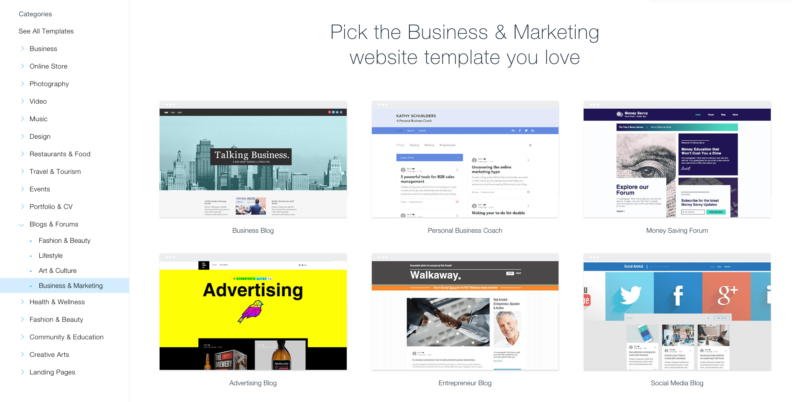
Wix gives you hundreds of beautiful templates for any type of blog. Easily customize any web page with its drag-and-drop editor. That means no coding knowledge required.
If you want even more help, they offer an ADI builder. This leverages artificial intelligence to help you build the exact website you want by just answering a few questions.
The blog manager is also simple and intuitive, with analytics and SEO built right in. It’s simple to add the basic features you might want on your blog, too—elements like social tools, likes, comments, hashtags, categories, and subscriber forms.
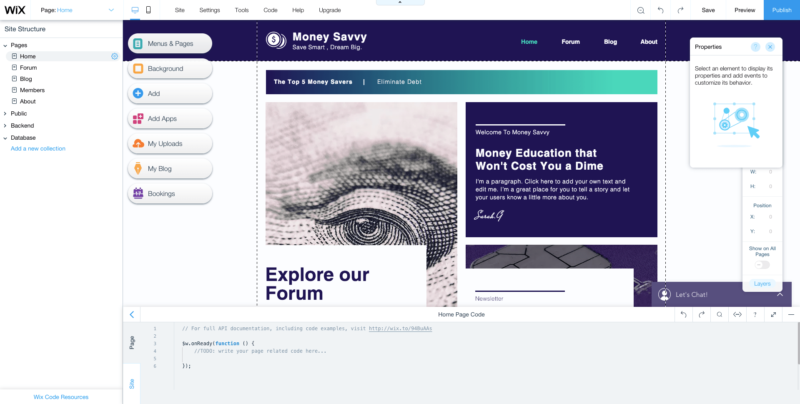
All of the SEO features you need are easy to access as well, from alt tags for your images and internal links to SEO titles and descriptions (that are different from you post title), and nofollow tags for external links.
One stand out feature is their automatic email subscription feature. That helps you collect leads right on your website with little to no effort. They also offer a social media bar beneath each article for sharing on Facebook, Twitter, and more.To build a blog on Wix, you just sign into your account and pick a template.
There’s a blog template category, which is a great place to start. Once you have your template selected, I suggest updating the font, colors, and logo to personalize your template and help it stand out from the rest.
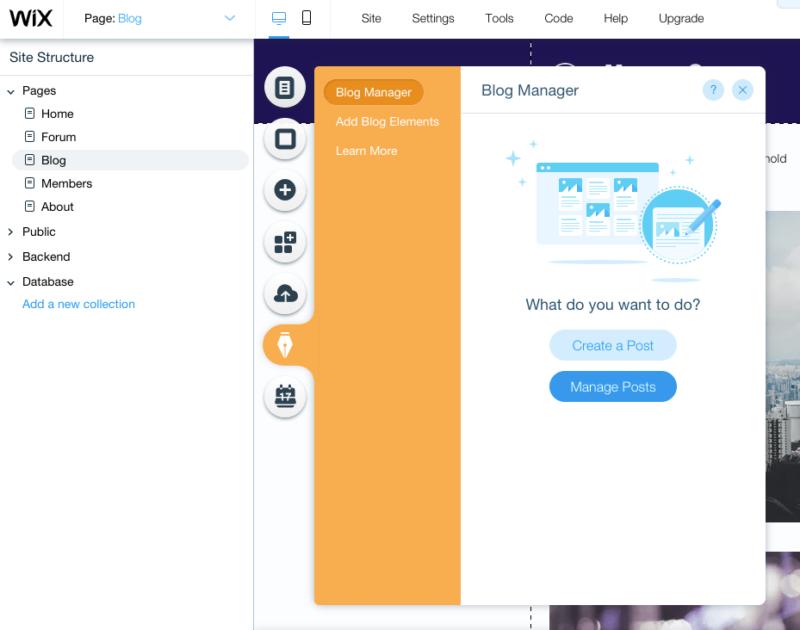
Writing a post is as simple as clicking Create a Post, writing your copy, and adding images. You can save drafts or even give other contributors writing privileges for your site. This is all just as easy from a mobile device as from a desktop—no app required.
Make sure that you update your SEO settings for every post. This is what’s presented in the search results page and is critical for ranking in organic search.
The resulting post will have a read-time count to show readers roughly how long it’ll take to go through your post, which I also like a lot.
I also like the ability to use live chat to interact with your readers in the Wix app. If you build a real community in your blog or are open to answering reader questions in real time—say, about an online course you’re offering or a webinar that’s coming up—then it’s a cool feature.
Pros and Cons of Creating a Wix Blog
Wix is a fantastic option if you want a simple but powerful blogging platform. With its drag-and-drop website builder, it’s an easy option if you’re looking to have your blog on your own site rather than on a blog platform or service like Medium or another form of social media.
The downside is you’ll be paying a subscription fee and you’ll be locked into Wix’s themes and tools. So, you’ll trade some convenience for some flexibility. For most users, we think this trade-off is worth it.
#2. WordPress with Bluehost Hosting – Most Customizable Blog Platform
- Highly customizable
- One-click WordPress install
- Powerful and reliable
- Prices start at $2.95/month
WordPress is one of the most popular website builders out there.
It’s incredibly flexible and powerful. WordPress allows you to make any kind of blog you want.
That’s not an exaggeration, either. Here are some examples of actual blogs powered by WordPress:
- Want a travel blog with a heavy emphasis on splashy travel photographs? WordPress can do it.
- Want to write about personal finance and development while selling info products? WordPress can do it.
- Do you run an incredibly popular social media platform for millions of business professionals across the world and want to give them great blog content? WordPress can do it.
They give you the tools and plugins you need to customize the platform to your exact needs and specifications.
And, it’s fairly simple. To build your own site, you’ll need to buy a domain name, get web hosting, and set up your WordPress account.
There’s more information on our posts about the best web hosting and the best web hosting for WordPress, which is about selecting a managed host that’s designed for WordPress.
The quick answer: Go with Bluehost.
Not only is Bluehost one of the most popular web hosts, it’s also ready-made for WordPress. They even recommend using Bluehost as a hosting option.
With just one click, you’ll be able to get your WordPress site up and running within minutes.
Bottom line: If you’re making a WordPress website, make it with Bluehost.
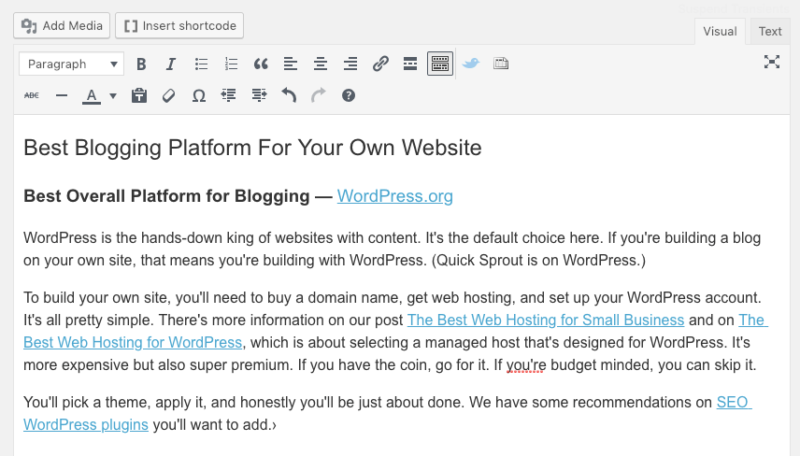
Building a WordPress website takes more time than a Wix website. However, the tradeoff is your website is much more customizable (and powerful).
You’ll be able to add the plugins you want and configure any of WordPress’s hundreds of themes on the backend to make your site look and feel exactly the way you want it to.
One important thing we should also mention is WordPress’s seamless integrations with sales funnels tools such as Salesforce or Hubspot. It’ll work with these tools to help you gather leads and turn them into paying, satisfied customers.
Pros and Cons of Blogging with WordPress
The main reason to use WordPress is for its complete scalability. No matter what you want to build or how big you get, WordPress can handle it.
They have plugins and widgets for every need. And if you really want, you can start changing the code yourself. WordPress is open-source, which means you can do whatever you want with it. If you know PHP or are willing to hire a developer, you can change WordPress however you like.
Plus, WordPress is incredibly popular. That means if you have any questions, there’s likely a wide variety of tips, tricks, and solutions you can find online.
But with that ultimate control, the trade-off is the platform’s learning curve.
You have to learn the ins and outs of WordPress, the plugins that work best for your site, where to find a theme that will make it beautiful, and how to write posts well.
It’s a lot to take in when building your first site. If you just want to launch your site so you can start blogging right away, WordPress won’t be the easiest option. But even if you’re uncomfortable with the responsibility at first, it’s also the best option if you’re willing to learn and grow into the role of managing your WordPress site.
#3. Squarespace – Best for Boosting Ecommerce Sales
- Embed products in blog posts
- Simple sync with your web store
- Free version + affordable paid plans
- Easy visual site builder
If you’re not blogging just to have a personal soapbox on the web, you likely want to make some money doing it. But if the content itself isn’t your product, you need a platform that will allow your blog to serve as an extension of your ecommerce site.
What you want, then, is Squarespace.
You get an all-in-one site builder, which is particularly handy if you’re starting up a web store and blog at the same time. It’s delightfully simple to create product pages with Squarespace’s easy ecommerce site builder and just as much of a breeze to embed products in your blog posts.
So, you can write great content that really piques visitors’ interest while making it easy for them to buy a product or service without ever leaving your blog post.
Already have a web store up and running elsewhere? No problem. Shopify, for example, offers an easy way to link your products on Shopify to your Squarespace blog. Less direct integrations—through Zapier or Automate.io—exist for platforms like WooCommerce, BigCommerce, and 3Dcart.
Though it may be redundant to use both Squarespace and another ecommerce platform, you can just lean on the free version of Squarespace for hosting your blog and leverage these integrations to showcase your products on it.
That alone can be worth it, because of how easy it is to build a captivating, visually pleasing blog in Squarespace’s visual editor.
Pros and Cons of Blogging with Squarespace
Ideally, Squarespace offers you a singular solution for having both a web store and blog that work in perfect harmony. The only drawback is that it will cost you a bit more to maximize Squarespace’s ecommerce capabilities.
But the paid plans aren’t prohibitively pricey:
- Personal: $12/month – comes with free custom domain, SSL, and unlimited storage
- Business: $18/month – comes with fully integrated ecommerce and unlimited products
- Basic Commerce: $26/month – comes with secure checkout, analytics, and no transaction fees
- Advanced Commerce: $40/month – comes with subscriptions and advanced shipping and discounts
All of those price points are for paying annually. The price jumps up a bit for each if you choose to go month-to-month.
Give Squarespace a try today and see how well you can leverage your blog to sell your products to more people.
#4. Medium – Best Blogging Platform for Building an Audience
- Completely free
- Audience of 60+ million readers
- High ceiling for virality
- Built-in comment section
Medium is home to more than 60 million users. These bloggers and content creators focus on crafting niche content for readers to settle down and read.
It’s also where you can find some of the most thought-provoking, incendiary content online. As such, their content has a higher ceiling for virality and you can take advantage of many communities of dedicated readers.
That makes it a great platform if you want to find and cultivate an audience of fans of your writing.
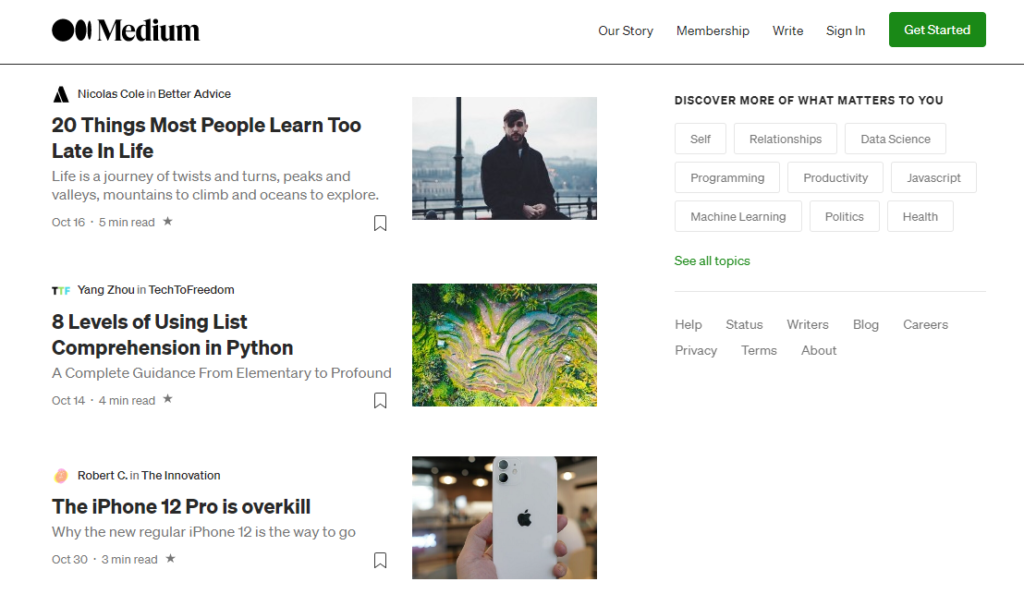
From personal experience, I know that when I read on Medium, I read with curiosity and intent. I’m ready to put in some time reading what’s there.
It also helps that they give you an estimate of how long it’ll take to read each article, as well as a built-in commenting system so you can immediately engage with the writer and other readers.
Posting with Medium is super simple too. There’s a clean, white WYSIWYG (what you see is what you get) editor. Basically, as you type, you see what the post will look like when it’s published.
Don’t stop at this point though. Instead of just a profile, I recommend creating a Medium Publication. This gives you the option to add other writers and editors to your blog. More importantly, it gives you a lot more options for controlling what is essentially your blog homepage.
Take a look below at the difference between Patagonia’s basic Medium profile (top image below) and Better Advice’s more magazine-style blog (bottom image below).

Above, a consecutive stream of your posts. This is all you’ll get with a Medium profile.
Below, the more magazine-style layout you’ll get with a Medium Publication.

One is a simple chronological feed and the other is a designed page with useful menu options. When you create a publication like REI’s, you also unlock the ability to send a newsletter to all of your followers.
However, Medium does have some drawbacks:
For one, you won’t be able to have your own customized URL. That can be a big drawback from a brand building perspective.
That said, you can adapt to that by pointing a custom domain to your Medium page.
You’re also going to have to rely much more on their algorithm in the initial stages of building an audience. That lack of control over your own platform could be a deal breaker for many of you.
But, if you already have a pretty well-established community, you could enhance it with Medium’s community.
Pros and Cons of a Medium Blog
Medium is the best all-around traditional blogging platform. It’s where the majority of readers who are looking to read classic blog-style posts are right now.
It’s the perfect platform for if you have a lot to say—and you want an audience to make your content a must-read every day or week.
The downside is built into the choice of picking to create your own blog or build one on a platform—you won’t own the traffic and you won’t be able to do things like sell ad placements, for example.
Deciding to blog on WordPress versus Medium isn’t an either-or choice. You can also publish your site and re-publish some posts on Medium to take advantage of its benefits, just like you would in any syndication deal.
You can thoughtfully approach this, but there are some technical how-tos to know.
You’ll need to import your posts to Medium properly and set the canonical tag, so you’re not penalized by Google (at worst) or simply out-ranked by the Medium version of the post (at best).
Overall, though, I prefer to see each channel as a separate channel and create and publish unique content for that channel.
#5. LinkedIn – Best Platform for Attracting B2B Prospects
- 740+ million users
- Ideal for B2B content
- Great for business blogging
- Free to use
LinkedIn is the social network for industry professionals.
They boast more than 590 million users, with 154 million of them in the US. And a lot of them are active, with 44% being monthly active users.
LinkedIn used to be basically a resume hosting platform. Think of it like a job-hunting dating app: you’d go on if you were looking to hire or looking to get hired but not much else. In the last few years, that has changed dramatically.
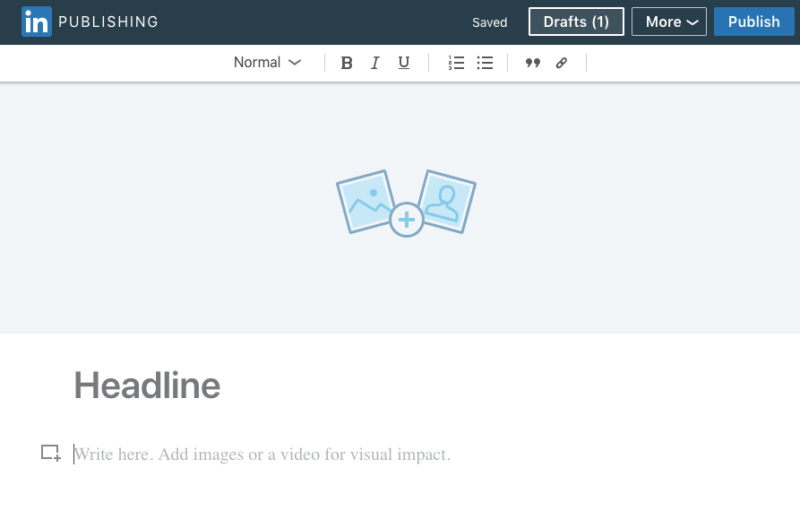
If you’re building a business blog, the audience on LinkedIn is your bread-and-butter. The platform has a ready-made culture and set of expectations that a business blogger would dream of creating on their own site.
LinkedIn is a social network. Your influence grows in proportion to the size of your network. The more posts you publish, the more connection requests and followers you’ll attract.
They also have a WordPress-style article editor. This provides more potential for professional, well-produced B2B content than any other social media platform.
Since it’s a social network for industry professionals, it makes it a great channel to access B2B prospects, along with getting quick feedback from peers on thought leadership. Easily turn your audience into partners and customers.
It’s worth noting that there are differences between a LinkedIn post and article. An article isn’t a post and vice versa.
A post is a smaller update you’d share with your feed and connections. Think along the lines of a quick anecdote or pro tip. They’re limited to 1,300 characters, which is about 5 lines.
Articles are longer and more in-depth, of course. They’re something that the broader LinkedIn audience would be interested in reading.
A person who reads your article can also follow you from there, so they’ll be alerted when you publish your next article. Any articles you publish will appear in the Articles section of your LinkedIn profile.
Want to improve? Check out LinkedIn’s own course on getting better at blogging on the platform, Writing to be Heard on LinkedIn. Because when they own the platform, what’s good for them is successful content that people want to read and engage with.
Pros and Cons of Blogging on LinkedIn
If you’re blogging about business or something related, like management, then I’d say to build your blog on LinkedIn. There’s a pre-existing community of people there talking about those topics and ready to read your posts, too. You’ll be able to build business followers, which is different than a “connection.”
If you’re building thought leadership, brand value, or community rather than trying to make money, I recommend going to where your audience is rather than trying to woo them over to where you are. Build content for them where they already are (like LinkedIn) and they’ll love you for it.
You’ll be able to build your network and your business opportunities, but like all blog platforms, the cons here are that you’re beholden to the algorithm and don’t own the site or the traffic.
How to Choose the Best Blogging Platform for You
The right platform for your business is ultimately going to be unique to your brand’s needs.
However, there are a few elements that we believe are universal applicable when it comes to looking for the right blogging platform.
Below are the four criteria we used to choose and rank our blogging platform picks in this article. Use them to help you when researching and deciding on the right one for you.
Easy Learning Curve
If you’re a new blogger, you probably don’t want to start out with an overly complex platform. You might feel ambitious and want to learn how to create a big website, but I highly recommend not doing so for two reasons:
- You’re going to get burned out—fast. It’s easy to bite off way more than you can chew in the beginning. When that happens, you’re going to end up getting tired of your blogging project very fast. You might even abandon it completely as a result.
- There are much easier (and better) ways to do it. All of the platforms on this list are easy to use, but some are easier to pick up than others.
So find a platform that lets you launch quickly, cheaply, and easily.
Medium and LinkedIn are really good options in that regard. The learning curve is very easy—you just create an account and you can start publishing immediately after.
You also don’t have to worry about things like domain names, web hosting, or even page customization with these choices. The platforms take care of all that for you.
If you’re not afraid to get your hands a little dirty, then I highly recommend Wix. They’ll ultimately give you the best combination of simplicity and website power.
Niche-Friendly Customization
Perhaps the most important decision you can make for your blog is what topic you’ll be writing about. This is going to determine your audience, its size, and your ultimate success.
No matter what you choose, though, you’re going to want to make sure that your blog allows you to customize its look and feel to fit your topic’s niche. This helps develop your blog and brand’s identity, and create a stronger relationship with your audience.
As you can see above, the websites that we reviewed do not all have the same level of customization. Platforms like Wix and WordPress give you many more opportunities to customize everything, from your website’s colors and article layouts to your domain name and the fonts that you use.
In fact, both Wix and WordPress offer thousands of themes you can use in order to choose the exact look and feel you want from your blog. They’re probably the best option if you want to go for a more traditional blog and own your own platform.
Websites like LinkedIn and Medium offer limited customization options, only giving you the ability to change your logo and the images in your blog posts. However, the tradeoff is that they offer better ways to grow your audience.
Readership Growth Tools
Good blogging platforms offer you different tools to grow your audience. This could come in the form of SEO tools (to help your posts rank better in search results) or they could help connect you with new readers on their own platform.
For example, Medium is a great blogging platform if you want to easily tap into a large, existing audience and go viral. Their algorithm can help your articles be discovered by interested readers in their newsletter or on their main feed. Medium sites also come with a built-in commenting system that lets you generate engagement as well.
Wix and WordPress have a variety of marketing tools, such as integrations with Google Analytics and SEO dashboards to help grow traffic. This is great if you want to have a much more hands on, under-the-hood approach to your growth strategy.
Profit Potential
Let’s be real: You want to make money with your blog. That’s totally fine. In fact, we encourage you to do so.
However, the blog platform you ultimately choose is going to have a massive impact on how much money you can possibly make and how you make it.
For example, with LinkedIn, you’ll be the most limited in your profit making potential. That’s because the platform won’t allow you to implement typical blog profit-making strategies such as on-page advertising.
Medium offers its Partner Program that allows writers to earn money on their articles based on “member engagement.” That means if other people read, comment, and like your story, you’ll be paid by Medium on the strength of that. But, you still won’t be able to earn money from advertising.
Of course, you can still use those sites to make money via strategies like affiliate marketing or selling coaching and other freelance services. But you’ll also be completely beholden to their algorithm for traffic. That means one algorithm change can mean the difference between making money and completely shuttering your business.
That’s not an exaggeration either. Algorithm changes have been notorious for shutting down once successful blogs by throttling their traffic.
If making money is important to you, then I highly recommend controlling your own platform by building your own blog with Wix or WordPress. That way, you won’t have to worry about algorithm changes ruining your traffic and you’ll be able to implement as many or as little profit making methods as you please.
Recap of the Best Blog Sites and Blog Platforms for 2021
Best Website Builder for Blogging — Wix
If you want control over your own site and keep things easy, go with Wix. It’s a drag-and-drop editor that’ll get you up and running quickly, and you’ll still be building your blog on your own website, not on someone else’s platform.
- 14-day free trial
- Drag and drop site builder
- Integrated payment processing
- 500+ ecommerce templates
Best Blog Software for Flexibility — WordPress with Bluehost Hosting
I’d recommend going this route to anyone serious about customizing your site and need complete control.
- One-click WordPress installation
- Fast and reliable
- Easy to get started
- Prices start at $2.95/month
Best for Boosting Ecommerce Sales — Squarespace
If you want a beautiful blog that also makes it easy to sell products within, look no further than Squarespace. With its product blocks feature, you can seamlessly highlight a product or service and allow blog reader to purchase it right then and there.
- Embed products in blog posts
- Simple sync with your web store
- Free version + affordable paid plans
- Easy visual site builder
Best Traditional Blogging Platform — Medium
If you’re not creating your own site and your blog is a classic blog — long-form posts about a topic that’s meaningful to you — I like Medium. It has a built-in audience that’s interested in reading and an interface that’s seamless.
Best Blog Site for Business — LinkedIn
Blogging about business or hoping to be a thought leader in a certain industry? You could go with Medium, but a more rabid and useful audience might be waiting for you on LinkedIn. I know, it might not seem like a blogging platform, but LinkedIn users are really engaged and hungry for content.
from Quick Sprout https://ift.tt/2AgqjKQ
via IFTTT



